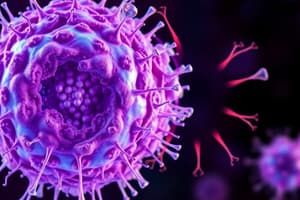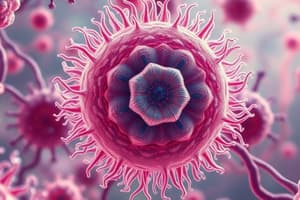Podcast
Questions and Answers
What distinguishes prokaryotic cells from eukaryotic cells?
What distinguishes prokaryotic cells from eukaryotic cells?
- Prokaryotic cells have circular DNA. (correct)
- Prokaryotic cells contain membrane-bound organelles.
- Prokaryotic cells undergo mitosis.
- Prokaryotic cells have a defined nucleus.
Which organelle is responsible for generating ATP through cellular respiration?
Which organelle is responsible for generating ATP through cellular respiration?
- Mitochondria (correct)
- Chloroplasts
- Golgi Apparatus
- Ribosomes
What is the primary function of the Golgi Apparatus?
What is the primary function of the Golgi Apparatus?
- Photosynthesis
- Protein synthesis
- Digestion of waste materials
- Modification and packaging of proteins (correct)
Which of the following processes involves the conversion of glucose and oxygen into ATP?
Which of the following processes involves the conversion of glucose and oxygen into ATP?
What type of cellular division results in four genetically diverse cells?
What type of cellular division results in four genetically diverse cells?
Which organelle is involved in lipid synthesis and detoxification?
Which organelle is involved in lipid synthesis and detoxification?
What term describes the structures that enable communication and adhesion between cells?
What term describes the structures that enable communication and adhesion between cells?
What is the primary role of ribosomes in a cell?
What is the primary role of ribosomes in a cell?
Which cellular process occurs in the chloroplasts of plant cells?
Which cellular process occurs in the chloroplasts of plant cells?
What is homeostasis in the context of cell biology?
What is homeostasis in the context of cell biology?
Flashcards are hidden until you start studying
Study Notes
Overview of Cell Biology
- Definition: Cell biology studies the structure, function, and behavior of cells, the basic unit of life.
Cell Types
-
Prokaryotic Cells
- Lack a nucleus and membrane-bound organelles.
- DNA is circular and located in the nucleoid region.
- Examples: Bacteria and Archaea.
-
Eukaryotic Cells
- Have a defined nucleus and membrane-bound organelles.
- DNA is linear and organized into chromosomes.
- Examples: Animal cells, plant cells, fungal cells, and protists.
Cell Structure
-
Plasma Membrane
- Phospholipid bilayer that controls the movement of substances in and out of the cell.
-
Cytoplasm
- Gel-like substance inside the cell where organelles are suspended.
-
Nucleus
- Contains genetic material (DNA) and controls cell activities.
-
Organelles
- Mitochondria: Powerhouse of the cell, generates ATP through cellular respiration.
- Ribosomes: Synthesize proteins; can be free-floating or attached to the endoplasmic reticulum.
- Endoplasmic Reticulum (ER):
- Rough ER: Studded with ribosomes; involved in protein synthesis.
- Smooth ER: Lacks ribosomes; involved in lipid synthesis and detoxification.
- Golgi Apparatus: Modifies, sorts, and packages proteins and lipids for secretion or delivery to organelles.
- Lysosomes: Contain enzymes for digestion; break down waste materials.
- Chloroplasts (in plants): Site of photosynthesis; contain chlorophyll.
Cellular Processes
-
Cellular Respiration
- Process by which cells convert glucose and oxygen into ATP, carbon dioxide, and water.
- Stages: Glycolysis, Krebs cycle, Oxidative phosphorylation.
-
Photosynthesis (in plants)
- Process by which plants convert sunlight, water, and carbon dioxide into glucose and oxygen.
- Stages: Light-dependent reactions and the Calvin cycle.
-
Cell Division
- Mitosis: Division of somatic cells resulting in two identical daughter cells.
- Meiosis: Division of gametes resulting in four genetically diverse cells.
Cellular Communication
- Signal Transduction: Process by which cells respond to external signals. Involves receptors, transducers, and effector molecules.
- Cellular Junctions: Structures that connect cells to each other and to the extracellular matrix, enabling communication and adhesion.
- Types: Tight junctions, gap junctions, desmosomes.
Key Concepts
- Homeostasis: The maintenance of a stable internal environment within cells.
- Cell Theory:
- All living organisms are composed of one or more cells.
- The cell is the basic unit of life.
- All cells arise from pre-existing cells.
Techniques in Cell Biology
- Microscopy: Techniques such as light microscopy and electron microscopy used to visualize cells and organelles.
- Cell Culture: Growing cells under controlled conditions for research and experimentation.
- Molecular Techniques: Including PCR, Western blotting, and CRISPR for studying cell function and genetics.
Cell Biology Fundamentals
- Cell Biology is the study of cells, the fundamental units of life, focusing on their structure, function, and behavior.
Cell Types
- Prokaryotic cells lack a nucleus and other membrane-bound organelles, with their DNA housed in a region called the nucleoid. Bacteria and Archaea are examples.
- Eukaryotic cells, in contrast, have a defined nucleus containing their linear DNA organized into chromosomes, and contain various membrane-bound organelles. Examples include animal, plant, fungal, and protist cells.
Cell Structure
- Plasma membrane acts as a selectively permeable barrier, regulating what enters and exits the cell. It's composed of a phospholipid bilayer.
- Cytoplasm is the gel-like substance within the cell where organelles are suspended.
- Nucleus, the control center of the cell, houses the genetic material (DNA) and regulates cellular activities.
Organelles
- Mitochondria, known as the "powerhouse" of the cell, generate ATP through cellular respiration.
- Ribosomes synthesize proteins, either free-floating within the cytoplasm or attached to the endoplasmic reticulum.
- Endoplasmic reticulum (ER) is a network of interconnected membranes involved in various functions:
- Rough ER is studded with ribosomes and participates in protein synthesis.
- Smooth ER lacks ribosomes and is involved in lipid synthesis and detoxification.
- Golgi apparatus modifies, sorts, and packages proteins and lipids for secretion or delivery to other organelles.
- Lysosomes contain digestive enzymes that break down waste materials.
- Chloroplasts (in plants) are responsible for photosynthesis, containing chlorophyll to capture sunlight energy.
Key Cellular Processes
- Cellular Respiration is the process by which cells convert glucose and oxygen into ATP (energy), carbon dioxide, and water. It involves three main stages: glycolysis, the Krebs cycle, and oxidative phosphorylation.
- Photosynthesis is the process plants utilize to convert sunlight, water, and carbon dioxide into glucose (energy) and oxygen. It consists of two stages: light-dependent reactions and the Calvin cycle.
- Cell division encompasses two main processes:
- Mitosis divides somatic cells into two identical daughter cells, involved in growth and repair.
- Meiosis is the division of gametes (sex cells) that results in four genetically diverse daughter cells, ensuring genetic variation in offspring.
Cellular Communication
- Signal transduction allows cells to respond to external signals. It involves receptors that bind to specific signals, transducers that relay the signal, and effector molecules that execute the response.
- Cellular junctions are structures that connect cells to each other and the extracellular matrix. These junctions facilitate communication and adhesion between cells. Different types include:
- Tight junctions seal cells together, preventing leakage.
- Gap junctions allow direct communication between cells through channels for the passage of small molecules.
- Desmosomes provide strong mechanical attachments between cells.
Central Concepts
- Homeostasis is the ability of a cell to maintain a stable internal environment, essential for its survival.
- Cell theory is a fundamental principle in biology, stating that:
- All living organisms are composed of one or more cells.
- The cell is the basic unit of life.
- All cells arise from pre-existing cells.
Techniques in Cell Biology
- Microscopy allows visualization of cells and organelles using various techniques:
- Light microscopy uses visible light to illuminate the specimen.
- Electron microscopy utilizes electron beams for higher resolution imaging of cellular structures.
- Cell culture involves growing cells in a controlled environment for research and experimentation.
- Molecular techniques, like PCR (polymerase chain reaction), Western blotting, and CRISPR, provide tools to study cell function and genetics.
Studying That Suits You
Use AI to generate personalized quizzes and flashcards to suit your learning preferences.




